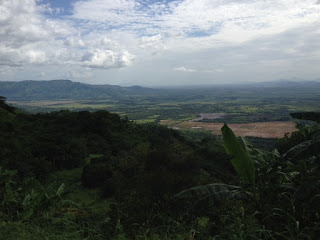Highlights:
· -- The power is out on the
mountain, and has been for a few days, and could be for the majority of the
week.
· -- Because the power is out, our
clinic had no electricity.
· -- Because the clinic had no
electricity, six young medical students learned how to do full pelvic exams and
pap smears using only headlamps for light.
· -- The HHA team performed
headlamp-exams and pap smears on nearly NINETY women on the first day!! (That’s
three times the normal amount!)
So yes, the first clinic day was a
success. We were serving the Espaveles
community, and we knew that there would be a good amount of people due to the
great turnout at their charlas. But I
don’t think anything prepared us for turning the corner in our chicken-truck
and seeing a line of at least fifty women at 7:30AM waiting to be checked in…
some of whom had been lined up since 5AM.
The line never seemed to get shorter
throughout the day. We hit the ground
running, beginning exams before 8AM and didn’t get back to El Corpus until well
after sunset. There has never been a
first day that took this long in the history of HHA! We told the women at the beginning of the day
that we would stay until every single woman had been seen, and we kept our
promise.
We were split into pairs again – one MS2
with one MS4 – and each pair took one patient at a time. Together they would do a full history, take
vitals, listen to the heart and lung, isolate the chief complaint, determine
which tests were needed, and prep the patient for a pelvic exam in one of our
four clinic rooms. The pair would then
find an available resident and formally present their case. If the resident signed off on their plan, she
would then enter the clinic room and oversee the students as they performed a
pelvic exam, bimanual exam, pap smear, and/or wet prep. When they were through, they would assess the
results of the exam and wet prep and come up with a treatment plan. One student would run to our make-shift
pharmacy, while the other cleaned and prepped the clinic room for another
patient. Pap smears were secured (with
hairspray) on slides and logged to be sent to ASHONPLAFA in Choluteca to be
read. The student pair would then have a
final meeting with the patient to tell them the results and advise them on any
medication or follow up they might need.
Pap smear results will be expedited and then we will personally deliver
the results to our villages next week—meeting individually with each woman.
For a first day, in the dark, with three
times as many patients as expected, we fared surprisingly well. Every patient was seen, all supplies were
restocked for tomorrow, all patients were properly examined and counseled, and
all slides for Pap smears were documented and recorded. Our leaders spent the day sterilizing
speculums and restocking the rooms with instruments when needed. KUDOS to Megan and Rachel for taking the
tough jobs and keeping everything super organized and flowing smoothly. The public health students worked “Intake”
and logged (and placated) every single patient that walked through our
door—keeping everything in order and being incredibly patient and upbeat and
resourceful. We also have three
wonderful residents/attendings who got into town under the cover of darkness
(literally) on Sunday, and spent all day today overseeing the rising second and
fourth year medical students and answering all of our questions. I’m sure it was an extremely long day for
them as well, but a MAJOR shout-out goes to Rupal, Ingwe, and Stacy who were
such professionals all day, and absolutely amazing leaders and role models to
all of us. THANK YOU.
And last but not least, all of the medical
students that had been waiting to get their hands dirty for quite a while – we
certainly jumped right into it. And we
definitely are impressed with the amount that we learned in a single day, but I
think the best part about it was the amazing energy put forth. It was a crazy day, and everybody had a
fantastic attitude throughout.
Go heels.























.jpg)

.jpg)


